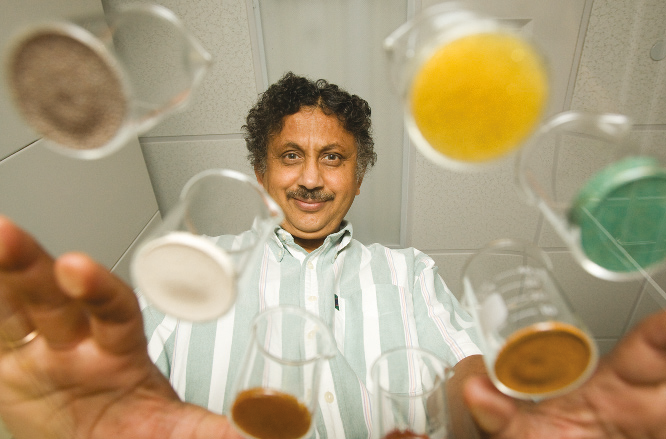A Lehigh invention that removes arsenic from groundwater is being used on four continents.
The technology, sold as ArsenXnp, utilizes a hybrid anion exchanger to disperse iron nanoparticles throughout a polymer-based bead. The nanoparticles selectively adsorb arsenic as well as phosphate, vanadate and other contaminants.
The patent has been awarded to Arup SenGupta, professor of civil and environmental engineering, and Luis Cumbal, who earned a Ph.D. in environmental engineering from Lehigh in 2005. Cumbal is now professor and director of graduate studies at the Army Engineering Polytechnic School in Quito, Ecuador.
ArsenXnp is licensed to SolmeteX Co. in Northborough, Mass., and manufactured by Purolite Co. of Philadelphia. It serves 300,000 people at more than 300 installations in nine states in the U.S., and is also in use in Hungary, India, Brazil and Ecuador.
In Eastern India, home to the world’s worst arsenic contamination, arsenic removal systems have been installed in the water wells of more than 150 villages. Arsenic levels in the wells have fallen from 100 to 500 parts per billion to below the 50-ppb limit set by the Indian government.
ArsenXnp is the first hybrid anion exchanger (HAIX) to intentionally exploit the 100-year-old Donnan effect and attain enhanced sorption of arsenate, arsenite, phosphate, chromate and other ligands, SenGupta says.
The effect, named for the British chemist Frederick G. Donnan (1870– 1956), refers to the failure of charged particles to distribute evenly across the two sides of a nearby semi-permeable membrane.
“HAIX is an anion exchanger within which hydrated iron oxide nanoparticles have been irreversibly dispersed,” says SenGupta. “Its synthesis posed a major challenge because the positively charged ferric ion is strongly rejected by an anion exchanger with a positively charged quaternary ammonium functional group.
“This challenge was overcome through a novel synthesis process that was scaled up for large-scale production. Very large amounts of hydrated Fe(III) oxide nanoparticles, nearly 25 percent by mass, can now be introduced within an anion exchanger.”
HAIX particles, says SenGupta, are not homogeneous at the microscale, but instead remain heterogeneous down to the level of 10 nanometers, where the simultaneous presence of quaternary ammonium functional groups and Fe(III) oxide nanoparticles in close proximity creates a synergy resulting in high sorption capacity and excellent kinetics.
SenGupta and Cumbal worked more than a year before they succeeded in preparing 2 grams of hybrid anion exchanger and dispersing iron oxide nanoparticles in 2003. Since then, they have refined and scaled up the process of synthesizing and dispersing the nanoparticles. Today, an estimated one million pounds of the hybrid nanosorbent is being used in the U.S.

